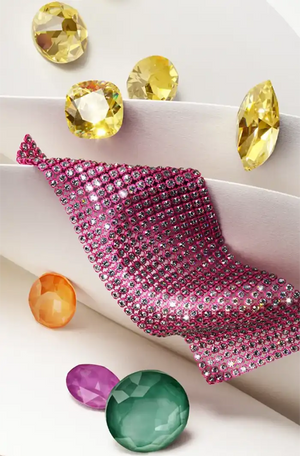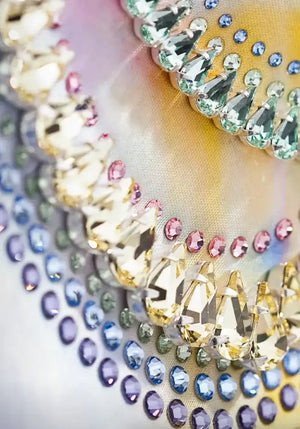
Electroplating Jewelry: What Is It And How Does It Work?
If you’ve ever admired the brilliant sheen of a gold-plated bracelet or the sleek finish of a rhodium-coated ring, you’ve already encountered the magic of electroplating. But what exactly is electroplating jewelry, and how does this process create such stunning results? Whether you’re a jewelry enthusiast or curious about how your favorite pieces achieve their impeccable look, this guide will take you through everything you need to know about electroplating.
What Is Electroplating?
Electroplating is a process that applies a thin layer of metal onto the surface of an object—like a piece of jewelry—using an electric current. This technique allows base metals, such as brass or copper, to be coated with precious metals like gold, silver, or rhodium, enhancing their appearance and durability.
The result is a beautiful, high-quality finish that looks like solid metal but is far more cost-effective. But electroplating isn’t just about aesthetics, it also protects jewelry from wear and tear, making it a practical choice for both manufacturers and wearers.
How Electroplating Works
The process of electroplating might sound complex, but it’s a fascinating combination of science and artistry. Here’s a closer look at how it works:
Jewelry is first thoroughly cleaned to remove dirt, oils, or oxidation that could affect the plating. It’s then submerged in an electrolyte solution containing the metal ions of the coating material. An electric current is passed through the solution, causing the metal ions to bond with the jewelry’s surface.
The thickness of the plating can be controlled by adjusting the amount of time the piece spends in the solution and the strength of the current. This precision ensures that the finished product meets specific design and durability requirements.
Benefits of Electroplating Jewelry
So why is electroplating such a popular choice in jewelry making? The benefits are as practical as they are beautiful.
Cost-Effective Solution
One of the biggest advantages of electroplating is its affordability. Instead of crafting an entire piece from a precious metal like gold or platinum, a base metal can be coated for a fraction of the cost. This makes high-end looks accessible to more people without compromising on style.
Variety of Finishes
Electroplating allows for a wide range of finishes, from high-shine yellow gold to sleek rhodium. Whether you prefer a vintage-inspired look or a contemporary aesthetic, electroplating makes it possible to customize pieces to suit any style.
Protection and Durability
Electroplating isn’t just for show—it also provides a protective layer that shields the underlying metal from tarnish, corrosion, and scratches. This added durability makes electroplated jewelry an excellent choice for everyday wear.
Applications of Electroplated Jewelry
Electroplating is more versatile than you might think, with applications across various types of jewelry and industries.
Types of Jewelry Commonly Electroplated
Rings, necklaces, earrings, and bracelets are often electroplated to enhance their look and feel. For instance, a sterling silver ring may be rhodium-plated to achieve a brilliant white finish and resist tarnishing. Even costume jewelry benefits from electroplating, giving budget-friendly pieces a high-end appearance.
Industries That Use Electroplating
Beyond personal adornment, electroplating is widely used in fashion, luxury goods, and even technology. The technique is essential for creating uniform finishes on everything from watches to eyewear, ensuring consistency and durability across various products.
If you’re inspired to experiment with jewelry making, check out our guide on how to solder jewelry to learn another essential technique for creating stunning pieces.
Caring for Electroplated Jewelry
While electroplated jewelry is designed to last, proper care is essential to maintain its beauty over time. Here’s how to keep your pieces looking their best.
Avoid Harsh Chemicals
Chemicals found in cleaning products, perfumes, and lotions can damage the plated finish. Always remove your jewelry before cleaning or applying products to your skin.
Store Properly
Keep your electroplated pieces in a soft pouch or lined jewelry box to prevent scratches. Storing each item separately is a good idea, as it minimizes the risk of metals rubbing against one another.
Limit Exposure to Water
While a quick rinse won’t harm most electroplated jewelry, prolonged exposure to water—especially chlorinated or saltwater—can wear down the coating. Be sure to remove your jewelry before swimming or showering.
Clean Gently
Use a soft cloth to clean your jewelry after each wear, removing any oils or dirt. For a deeper clean, a mild soap and warm water solution can work wonders, but always dry thoroughly to prevent moisture damage.
Be Mindful of Wearing Conditions
Activities like heavy lifting or gardening can put undue stress on your jewelry, leading to scratches or chipping. Save your electroplated pieces for less strenuous occasions to keep them in pristine condition.
Final Thoughts
Electroplating jewelry is a fascinating blend of science and art that offers endless possibilities for design and durability. Whether it’s enhancing the shine of a favorite ring or creating an entirely new look, this process allows for incredible versatility without the high cost of solid precious metals.
And if you’re looking for inspiration, explore our collection of beautiful Swarovski crystals to add a dazzling touch to your own jewelry designs.
With proper care, electroplated jewelry can stay as stunning as the day you bought it, proving that beauty and practicality can go hand in hand. Whether you’re a jewelry maker or a collector, there’s no denying its charm.








